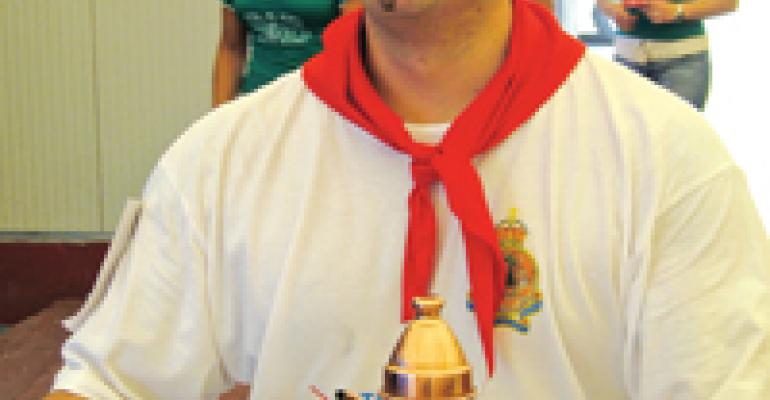Tony Gemignani’s eight world dough-tossing acrobatics titles have made his name almost synonymous with the quirky craft of spinning the skins.
But when the co-owner of Pyzano’s Pizzeria in Castro Valley, Calif., entered the Trofeo Citta di Napoli Championato Internazionale per Pizzaioli—which translates to the City of Naples Trophy, International Championship of Pizza Makers—pizza-baking contest last month in Naples, he was virtually unknown.
Until he won it.
The American Gemignani shocked even himself by winning the STG—essentially “standard traditional guaranteed”—portion of the competition, which centered on the extraordinarily technical baking of true Neapolitan pizza.
“It was a bit surreal. I really couldn’t even believe it,” said Gemignani, 33. “Winning in Naples is something I’ve always wanted to do.”
According to Nancy Puglisi, one of the event’s coordinators, the judges were the only ones who were not surprised.
“They couldn’t stop eating his pizza, and they taste a lot of pizzas in a contest like this,” she said.
In just its second year, the City of Naples Trophy contest is viewed by some as Italy’s top competition because of the reputations of its organizers and judges—the Margherita Regina association. The group is made up of Naples’ master pizza makers, including its president, Ernesto Cacialli, owner of El Presidente, the city’s most decorated pizzeria. Cacialli has served pizza to several U.S. presidents, and he teaches the art of Neapolitan pizza making around the world.
“They serve 2,000 pizzas a day at his place, which is unbelievable,” Gemignani said. “I’d have to say his is the best pizza I’ve ever had.”
Whereas pizza-baking contests typically focus on presentation and taste, Naples Trophy competitors are judged on those attributes as well as on the ingredients, preparations and techniques they use. Dough is made only from water, “00” Italian flour, naturally occurring yeast and Italian sea salt. It is made either by hand or in mixers that don’t produce heat.
Contestants use fresh mozzarella made from water buffalo’s milk or cow’s milk, and D.O.P.-certified San Marzano tomatoes, which means the tomatoes come from a protected region near Mount Vesuvius.
“Every dough ball has to weigh between 180 and 220 grams and be stretched to form a 13-inch pizza,” Gemignani said. “That’s incredibly difficult to do when you’re used to thicker American dough.”
Neapolitan pizzas bake at 900 degrees Fahrenheit in wood-fired ovens for a brisk 90 seconds.
“Let’s just say you don’t turn your back on it,” Gemignani said.
Two years ago, Gemignani threw himself full time into the study of Neapolitan pizza making through classes in Italy, and he built a wood-fired oven in his backyard to practice it.
Having accompanied her husband on trips to Italy and eating a fair amount of Neapolitan pizza, Julie Gemignani became his designated taster.
“As the contest got closer, I ate Margherita pizza every day for a couple of months,” she said. “But that’s not a bad thing. I could eat it every day.”
The surprise of her husband’s win “was emotional for everyone,” Julie said. “I don’t remember seeing so many grown men about to cry at something like this.” She was referring to three of Tony Gemignani’s teary-eyed teammates on the World Pizza Champions team. The WPC includes more than two dozen American pizzeria owners who compete all over the world.
“That sounds corny to someone who wasn’t there, but this is that hard to do,” said teammate William Manzo, owner of Federal Hill Pizza Co. in Providence, R.I. Manzo’s pizza operation also includes a retail dough sales arm. “I know dough, so I knew exactly what he did in winning. It was big.”
However, some of the Italians weren’t so impressed, Puglisi said. Several accused the judges of favoring the young American for publicity’s sake, but she called such controversy common to any Italian contest.
“[The Neapolitans would] have said the same thing if it was an Italian from Milan who won,” said Puglisi, an American who settled in Sicily three years ago. “The fact is the judges wouldn’t have risked their reputations to do that.”
Manzo said that when the trophy was presented, the judges made clear Gemignani had out-classed the field in several respects. His pizza was top notch, as were his tools and uniform, which also were critiqued by judges.
“They basically pointed to Tony and said, ‘Look and learn,’ ” Manzo said. “Tony showed up totally prepared for this.”
Other Italians, including Cacciali, congratulated Gemignani for his victory and gave him and his teammates heroes’ welcomes at their pizzerias.
“They brought us in like we were family,” Gemignani said. Gemignani said much of the Neapolitans’ enthusiasm for his win springs from a desire to see true Neapolitan pizza spread throughout the United States.
In Italy, authentic Neapolitan pizza must be made in Naples, but to market pizza as crafted in the Neapolitan style, a pizzeria must be approved by Verace Pizzaioli Napoletani, a governing body within Italy’s ministry of agriculture. Foreign pizza makers can become VPN-certified, but the process is lengthy and arguably impractical for business owners who can’t be away long. Now, Gemignani is working with Margherita Regina to develop VPN courses that he will teach in America. Students, however, will still have to finish their certification in Naples.
“The Neapolitans want the U.S. to know how pizza really is at its roots,” said Gemignani, who is renting a wood-fired oven to make Neapolitan-style pizza on weekends at Pyzano’s. “And now that I’ve won, I’ll be able to showcase this in the United States.”




